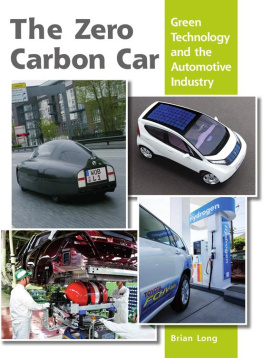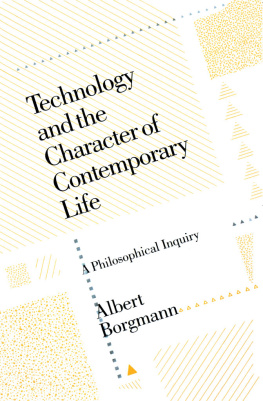DRIVER ACCEPTANCE OF NEW TECHNOLOGY
Human Factors in Road and Rail Transport
Series Editors
Dr Lisa Dorn
Director of the Driving Research Group, Department of Human Factors, Cranfield University
Dr Gerald Matthews
Professor of Psychology at the University of Cincinnati
Dr Ian Glendon
Associate Professor of Psychology at Griffith University, Queensland, and President of the Division of Traffic and Transportation Psychology of the International Association of Applied Psychology
Todays society confronts major land transport problems. Human and financial costs of road vehicle crashes and rail incidents are increasing, with road vehicle crashes predicted to become the third largest cause of death and injury globally by 2020. Several social trends pose threats to safety, including increasing vehicle ownership and traffic congestion, advancing technological complexity at the human-vehicle interface, population ageing in the developed world, and ever greater numbers of younger vehicle drivers in the developing world.
Ashgates Human Factors in Road and Rail Transport series makes a timely contribution to these issues by focusing on human and organisational aspects of road and rail safety. The series responds to increasing demands for safe, efficient, economical and environmentally-friendly land-based transport. It does this by reporting on state-of-the-art science that may be applied to reduce vehicle collisions and improve vehicle usability as well as enhancing driver wellbeing and satisfaction. It achieves this by disseminating new theoretical and empirical research generated by specialists in the behavioural and allied disciplines, including traffic and transportation psychology, human factors and ergonomics.
The series addresses such topics as driver behaviour and training, in-vehicle technology, driver health and driver assessment. Specially commissioned works from internationally recognised experts provide authoritative accounts of leading approaches to real-world problems in this important field.
Driver Acceptance
of New Technology
Theory, Measurement and Optimisation
Edited by
MICHAEL A. REGAN
University of New South Wales, Australia
TIM HORBERRY
University of Queensland, Australia, and University of Cambridge, UK
ALAN STEVENS
Transport Research Laboratory (TRL), UK
ASHGATE
Michael A. Regan, Tim Horberry and Alan Stevens and the contributors 2014
All rights reserved. No part of this publication may be reproduced, stored in a retrieval system or transmitted in any form or by any means, electronic, mechanical, photocopying, recording or otherwise without the prior permission of the publisher.
Michael A. Regan, Tim Horberry and Alan Stevens have asserted their right under the Copyright, Designs and Patents Act, 1988, to be identified as the editors of this work.
Published by
Ashgate Publishing Limited
Wey Court East
Union Road
Farnham
Surrey, GU9 7PT
England
Ashgate Publishing Company
110 Cherry Street
Suite 31
Burlington, VT 054013818
USA
www.ashgate.com
British Library Cataloguing in Publication Data
A catalogue record for this book is available from the British Library
The Library of Congress has cataloged the printed edition as follows:
Regan, Michael A., author.
Driver acceptance of new technology: theory, measurement and optimisation / by Michael A. Regan, Tim Horberry and Alan Stevens.
pages cm(Human factors in road and rail transport)
Includes bibliographical references and index.
ISBN 978-1-4094-3984-4 (hardback: alk. paper)ISBN 978-1-4094-3985-1 (ebook) ISBN 978-1-4724-0585-2 (epub)
1. Motor vehicle driversPsychology. 2. Motor vehicle driversAttitudes. 3. AutomobilesTechnological innovations. 4. Highway engineeringTechnological innovations. 5. Motor vehicle drivingTechnological innovationsPsychological aspects. 6. Highway communicationsTechnological innovations. 7. Traffic safety Technological innovations. I. Horberry, Tim, author. II. Stevens, A. (Researcher in transportation), author. III. Title. IV. Series: Human factors in road and rail transport.
TL152.3.R38 2014
629.28304dc23
2013025915
ISBN 9781409439844 (hbk)
ISBN 9781409439851 (ebk-PDF)
ISBN 9781472405852 (ebk-ePUB)
Contents
Michael A. Regan, Alan Stevens and Tim Horberry
Emeli Adell, Andrs Vrhelyi and Lena Nilsson
Emeli Adell, Andrs Vrhelyi and Lena Nilsson
Sven Vlassenroot and Karel Brookhuis
Mahtab Ghazizadeh and John D. Lee
Emeli Adell, Lena Nilsson and Andrs Vrhelyi
Eve Mitsopoulos-Rubens and Michael A. Regan
Robert Edmunds, Lisa Dorn and Lee Skrypchuk
Jan-Erik Kllhammer, Kip Smith and Erik Hollnagel
Gary Burnett and Cyriel Diels
Elodie Labeye, Corinne Brusque and Michael A. Regan
Roman Vilimek and Andreas Keinath
Vronique Huth
Alan Stevens and Nick Reed
Tim Horberry and Tristan Cooke
Matts-ke Belin, Evert Vedung, Khayesi Meleckidzedeck and Claes Tingvall
Alan Stevens and Gary Burnett
William S. Green and Patrick W. Jordan
Martin C. Maguire
Jan-Willem van der Pas, Warren E. Walker, Vincent Marchau and Sven Vlassenroot
Kristie L. Young and Christina M. Rudin-Brown
Alan Stevens, Tim Horberry and Michael A. Regan
List of Figures
List of Tables
About the Editors
Michael A. Regan is currently a Professor in the Transport and Road Safety Research group in the School of Aviation at the University of New South Wales, in Sydney, Australia. Before that he held research appointments with the French Institute of Science and Technology for Transport, Development and Networks (IFFSTAR) in Lyon, France, and the Monash University Accident Research Centre in Melbourne, Australia. Mikes current research interests focus on human interaction with, and acceptance of, intelligent transport systems, driver distraction and inattention, use of instrumented vehicles for naturalistic observation of driver and pilot behaviour, and aviation safety. He sits on the Editorial Boards of five peer-reviewed journals, including Human Factors, is the author of more than 200 publications, including two books, and sits on numerous expert committees on traffic safety. He is the 25th President of the Human Factors and Ergonomics Society of Australia.
Tim Horberry is Associate Professor of Human Factors at the University of Queensland, Australia. He is also a Senior Research Associate at the University of Cambridge, UK, and before that he was at the UKs Transport Research Laboratory. Tim has published his work widely, including four books published either by Ashgate or CRC press: The Human Factors of Transport Signs (2004) and Human Factors in the Maritime Domain (2008), Understanding Human Error In Mine Safety (2009) and Human Factors for the Design, Operation and Maintenance of Mining Equipment (2010). Tim has undertaken many applied Human Factors research projects in Australia, the UK and Europe for organisations such as the European Union, Australian Research Council and the UK Department for Transport. Currently Tim is leading several projects in the minerals industry that are examining acceptance of new technology for mining vehicles including collision detection systems and shovel automation.
Next page









